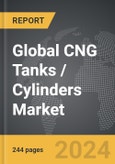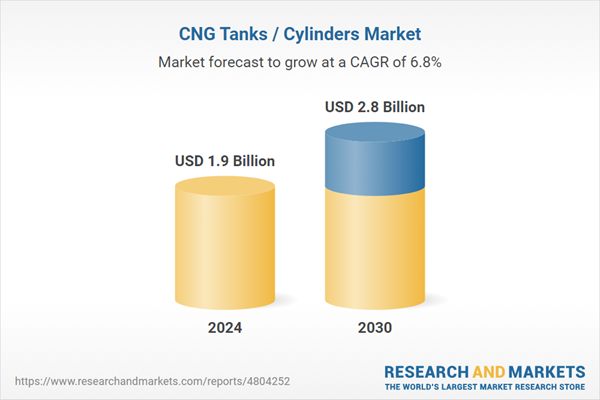The global market for CNG Tanks / Cylinders was valued at US$1.9 Billion in 2024 and is projected to reach US$2.8 Billion by 2030, growing at a CAGR of 6.8% from 2024 to 2030. This comprehensive report provides an in-depth analysis of market trends, drivers, and forecasts, helping you make informed business decisions.
CNG tanks come in various types, categorized based on their material construction. Type 1 cylinders are made entirely of metal, usually steel, and offer durability at a relatively low cost but come with a weight disadvantage. Type 2, 3, and 4 cylinders incorporate lightweight composite materials, with Type 4 being the lightest and most advanced, featuring a plastic liner fully wrapped with carbon fiber. This progression in cylinder design allows for higher energy efficiency and longer vehicle ranges while reducing overall vehicle weight, making these tanks integral to modern CNG vehicle fleets. The growing adoption of composite cylinders highlights the ongoing innovation in CNG storage technology, which is essential for meeting the increasing demand for lighter, safer, and more efficient natural gas storage solutions.
Global CNG Tanks / Cylinders Market - Key Trends and Drivers Summarized
Why Are CNG Tanks/Cylinders Critical for the Adoption of Clean Energy?
CNG (Compressed Natural Gas) tanks, also known as cylinders, are essential components in the global shift toward cleaner, more sustainable energy. CNG is widely regarded as a greener alternative to gasoline and diesel, offering lower carbon emissions and reducing air pollution in both transportation and industrial applications. CNG tanks store the natural gas in a highly compressed form, typically at pressures of up to 3,600 psi, making it possible to fuel vehicles and power industrial machinery efficiently. These cylinders must be robust enough to safely contain the gas under extreme pressure while being lightweight enough for practical use in vehicles. As CNG continues to be adopted in sectors such as public transport, commercial fleets, and even private vehicles, the demand for high-quality, safe, and durable tanks is increasing. The role of CNG tanks is critical not just in enabling the use of this cleaner fuel but also in ensuring its safe and efficient transport and storage, making them an indispensable part of the infrastructure needed to support the widespread use of natural gas.What Makes CNG Tanks/Cylinders So Specialized?
The specialized nature of CNG tanks and cylinders stems from the technical requirements necessary to store compressed natural gas at extremely high pressures. These tanks must meet strict safety standards to prevent leaks or ruptures, which could result in dangerous explosions or fires. To address these risks, CNG cylinders are typically made from materials that are both strong and lightweight, such as high-strength steel, aluminum, or advanced composite materials like carbon fiber. Each material offers different advantages - composite cylinders, for instance, are lighter and more corrosion-resistant than steel, making them particularly suitable for vehicles where weight is a critical factor. In addition to their material composition, CNG tanks must undergo rigorous testing and certification to ensure they can withstand not only the high pressures of natural gas storage but also external conditions like impact, extreme temperatures, and exposure to chemicals.CNG tanks come in various types, categorized based on their material construction. Type 1 cylinders are made entirely of metal, usually steel, and offer durability at a relatively low cost but come with a weight disadvantage. Type 2, 3, and 4 cylinders incorporate lightweight composite materials, with Type 4 being the lightest and most advanced, featuring a plastic liner fully wrapped with carbon fiber. This progression in cylinder design allows for higher energy efficiency and longer vehicle ranges while reducing overall vehicle weight, making these tanks integral to modern CNG vehicle fleets. The growing adoption of composite cylinders highlights the ongoing innovation in CNG storage technology, which is essential for meeting the increasing demand for lighter, safer, and more efficient natural gas storage solutions.
How Are CNG Tanks/Cylinders Evolving to Meet New Industry Demands?
The development of CNG tanks and cylinders is rapidly evolving in response to new trends in energy, transportation, and environmental regulation. One of the most significant shifts is the increasing focus on lightweight materials that enhance fuel efficiency and vehicle performance. As industries such as transportation and logistics shift toward CNG-powered vehicles to meet stricter emission regulations, there is a growing demand for lighter, more efficient CNG tanks. This has driven the adoption of advanced composite materials like carbon fiber, which reduce the weight of CNG cylinders by up to 70% compared to traditional steel tanks. Lighter tanks allow vehicles to carry more fuel without sacrificing load capacity or increasing fuel consumption, which is critical for long-haul trucks, buses, and other commercial vehicles that require extended range and payload efficiency. Another important trend is the integration of smart technologies into CNG cylinders. Sensors and digital monitoring systems are increasingly being embedded into tanks to provide real-time data on pressure, temperature, and gas levels. This allows for more accurate fuel management, better safety monitoring, and predictive maintenance, reducing the risk of failures and ensuring optimal performance over the lifetime of the tank. Moreover, the growing focus on sustainability is pushing manufacturers to develop tanks that are more environmentally friendly, both in terms of the materials used and their recyclability at the end of their life cycle. Innovations like the use of bio-based resins in composite cylinders and the development of modular tank designs that are easier to maintain and recycle are helping to align the CNG tank industry with broader sustainability goals. Additionally, CNG tanks are evolving to support the rise of renewable natural gas (RNG), also known as biogas, which is produced from organic waste. As RNG becomes more integrated into the energy mix, there is increasing demand for tanks that can store this renewable fuel, further reducing the carbon footprint of vehicles and industrial processes.What Are the Factors Behind the Growth of the CNG Tanks/Cylinders Market?
The growth in the CNG tanks/cylinders market is driven by several key factors. First, the increasing adoption of CNG as a fuel alternative in the transportation sector is a major driver. Governments worldwide are implementing stricter emissions regulations and promoting the use of alternative fuels to combat climate change and reduce urban air pollution. As a result, more public transportation fleets, commercial trucking companies, and even individual consumers are turning to CNG-powered vehicles, which in turn increases demand for reliable, high-quality CNG tanks. Another important growth driver is the rise in infrastructure development for CNG refueling stations, particularly in emerging economies where natural gas is seen as a key component of energy diversification strategies. The expansion of CNG refueling networks is making it more convenient for consumers and businesses to adopt CNG vehicles, boosting the demand for CNG tanks and cylinders. Additionally, the industrial sector is increasingly using CNG as a fuel for processes such as heating, power generation, and machinery operation, further expanding the market for CNG storage solutions. The push toward greater fuel efficiency and reduced vehicle weight is also contributing to market growth, particularly with the increasing use of composite materials for CNG tanks. These lightweight tanks offer longer driving ranges and reduced fuel consumption, making them especially attractive to commercial fleet operators who are looking to lower operational costs while meeting environmental regulations. Finally, the growing use of renewable natural gas (RNG) in both transportation and industrial applications is providing an additional boost to the CNG tanks market, as RNG adoption requires the same storage infrastructure as conventional CNG, but with the added environmental benefit of using a carbon-neutral fuel. These factors are all working together to drive the growth of the CNG tanks and cylinders market, positioning it as a key enabler of the global transition to cleaner, more sustainable energy sources.Report Scope
The report analyzes the CNG Tanks / Cylinders market, presented in terms of market value (US$ Thousand). The analysis covers the key segments and geographic regions outlined below.Segments
Material (Carbon Fiber, Glass Fiber, Metal); Vehicle Type (Light Duty Vehicles, Medium Duty Vehicles, Heavy Duty Vehicles).Geographic Regions/Countries
World; United States; Canada; Japan; China; Europe (France; Germany; Italy; United Kingdom; Spain; Russia; and Rest of Europe); Asia-Pacific (Australia; India; South Korea; and Rest of Asia-Pacific); Latin America (Argentina; Brazil; Mexico; and Rest of Latin America); Middle East (Iran; Israel; Saudi Arabia; United Arab Emirates; and Rest of Middle East); and Africa.Key Insights:
- Market Growth: Understand the significant growth trajectory of the Carbon Fiber Material segment, which is expected to reach US$1.6 Billion by 2030 with a CAGR of a 8.0%. The Glass Fiber Material segment is also set to grow at 6.3% CAGR over the analysis period.
- Regional Analysis: Gain insights into the U.S. market, valued at $509.4 Million in 2024, and China, forecasted to grow at an impressive 11.1% CAGR to reach $664.6 Million by 2030. Discover growth trends in other key regions, including Japan, Canada, Germany, and the Asia-Pacific.
Report Features:
- Comprehensive Market Data: Independent analysis of annual sales and market forecasts in US$ Million from 2024 to 2030.
- In-Depth Regional Analysis: Detailed insights into key markets, including the U.S., China, Japan, Canada, Europe, Asia-Pacific, Latin America, Middle East, and Africa.
- Company Profiles: Coverage of major players such as AVANCO GmbH, Beijing Tianhai Industry Co., Ltd., Everest Kanto Cylinder Ltd., Faber Industrie Spa, Hexagon Composites ASA and more.
- Complimentary Updates: Receive free report updates for one year to keep you informed of the latest market developments.
Why You Should Buy This Report:
- Detailed Market Analysis: Access a thorough analysis of the Global CNG Tanks / Cylinders Market, covering all major geographic regions and market segments.
- Competitive Insights: Get an overview of the competitive landscape, including the market presence of major players across different geographies.
- Future Trends and Drivers: Understand the key trends and drivers shaping the future of the Global CNG Tanks / Cylinders Market.
- Actionable Insights: Benefit from actionable insights that can help you identify new revenue opportunities and make strategic business decisions.
Key Questions Answered:
- How is the Global CNG Tanks / Cylinders Market expected to evolve by 2030?
- What are the main drivers and restraints affecting the market?
- Which market segments will grow the most over the forecast period?
- How will market shares for different regions and segments change by 2030?
- Who are the leading players in the market, and what are their prospects?
Some of the 42 major companies featured in this CNG Tanks / Cylinders market report include:
- AVANCO GmbH
- Beijing Tianhai Industry Co., Ltd.
- Everest Kanto Cylinder Ltd.
- Faber Industrie Spa
- Hexagon Composites ASA
- Lianyungang Zhongfu Lianzhong Composites Group Co., Ltd.
- Luxfer Holdings PLC
- Quantum Fuel Systems Technologies Worldwide, Inc.
- Ullit SA
- Worthington Industries
Table of Contents
I. METHODOLOGYII. EXECUTIVE SUMMARY2. FOCUS ON SELECT PLAYERSIII. MARKET ANALYSISSOUTH KOREAREST OF ASIA-PACIFICARGENTINABRAZILMEXICOREST OF LATIN AMERICAIRANISRAELSAUDI ARABIAUNITED ARAB EMIRATESREST OF MIDDLE EASTIV. COMPETITION
1. MARKET OVERVIEW
3. MARKET TRENDS & DRIVERS
4. GLOBAL MARKET PERSPECTIVE
UNITED STATES
CANADA
JAPAN
CHINA
EUROPE
FRANCE
GERMANY
ITALY
UNITED KINGDOM
SPAIN
RUSSIA
REST OF EUROPE
ASIA-PACIFIC
AUSTRALIA
INDIA
LATIN AMERICA
MIDDLE EAST
AFRICA
Companies Mentioned (Partial List)
A selection of companies mentioned in this report includes, but is not limited to:
- AVANCO GmbH
- Beijing Tianhai Industry Co., Ltd.
- Everest Kanto Cylinder Ltd.
- Faber Industrie Spa
- Hexagon Composites ASA
- Lianyungang Zhongfu Lianzhong Composites Group Co., Ltd.
- Luxfer Holdings PLC
- Quantum Fuel Systems Technologies Worldwide, Inc.
- Ullit SA
- Worthington Industries
Table Information
| Report Attribute | Details |
|---|---|
| No. of Pages | 244 |
| Published | April 2025 |
| Forecast Period | 2024 - 2030 |
| Estimated Market Value ( USD | $ 1.9 Billion |
| Forecasted Market Value ( USD | $ 2.8 Billion |
| Compound Annual Growth Rate | 6.8% |
| Regions Covered | Global |









